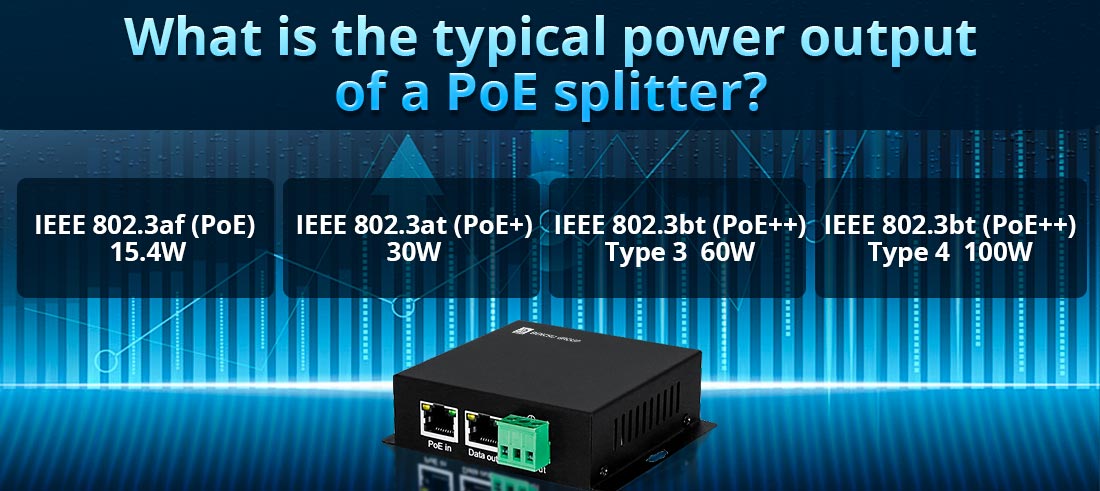
Un divisor de POE extrae potencia de un cable Ethernet habilitado para POE (típicamente 48V-57V DC) y la convierte en un voltaje más bajo adecuado para dispositivos que no son POE. La potencia de salida de un divisor de POE depende del estándar POE que admite (IEEE 802.3af, 802.3at o 802.3bt).
1. Niveles estándar de salida de potencia de los divisores de POE
Poe Splitters Comúnmente proporciona salida de CC a diferentes voltajes, como 5V, 9V, 12V y 24 V, dependiendo de las necesidades del dispositivo conectado.
| Estándar de Poe | Potencia de entrada máxima | Potencia utilizable (después de la pérdida) | Voltajes típicos de salida de divisor | Dispositivos compatibles |
| IEEE 802.3AF (Poe) | 15.4W | 12.95W | 5V / 9V / 12V | Cámaras IP básicas, teléfonos VoIP, dispositivos IoT |
| IEEE 802.3at (Poe+) | 30W | 25.5W | 5V / 9V / 12V / 24V | Cámaras PTZ, puntos de acceso, controladores industriales |
| IEEE 802.3BT (POE ++) Tipo 3 | 60W | 51W | 12V / 24V / 48V | Wi-Fi 6 APS de alta potencia, pantallas LED, sistemas integrados |
| IEEE 802.3BT (POE ++) Tipo 4 | 100W | 71W | 12V / 24V / 48V | Iluminación inteligente, señalización digital, mini PC, dispositivos industriales |
2. Configuraciones comunes de salida de divisor de POE
(a) Salida de 5V (dispositivos de baja potencia)
Típicamente utilizado para productos electrónicos pequeños, como:
--- Raspberry Pi y computadoras de una sola tabla
--- sensores de IoT
--- Dispositivos con energía USB
Dibuja el poder de las fuentes Poe (802.3af) o Poe+ (802.3at).
(b) Salida de 9V (dispositivos de potencia media)
Adecuado para algunos dispositivos de red y controladores integrados, que incluyen:
--- ciertos sensores industriales
--- Puntos de acceso más antiguos
--- Equipo de red personalizado
(c) salida de 12V (dispositivos de red estándar)
La salida más común para los divisores de POE.
Compatible con muchos dispositivos de redes que no son de POE, como:
--- Cámaras IP
--- teléfonos voip
--- Convertidores de medios de red
--- reproductores de señalización digital
(d) salida de 24 V (dispositivos de alta potencia)
Utilizado para dispositivos de redes más grandes, que incluyen:
--- Puntos avanzados de acceso inalámbrico
--- Cámaras de seguridad PTZ (Pan-Tilt-Zoom)
--- Equipo industrial
(e) salida de 48V (aplicaciones de alta potencia)
Requerimiento Poe ++ (802.3BT Tipo 3 o Tipo 4) Fuentes de energía.
Adecuado para dispositivos de grado empresarial, que incluyen:
--- Puntos de acceso Wi-Fi 6 de alto rendimiento
--- quioscos digitales y pantallas interactivas
--- Sistemas de iluminación inteligente
3. Cómo elegir el divisor de poe correcto
Paso 1: Determine los requisitos de energía de su dispositivo
--- Verifique el voltaje y la potencia que necesita su dispositivo que no sea POE (por ejemplo, ¿requiere 12V CC a 1A?).
Paso 2: Haga coincidir el estándar de Poe
--- Si su interruptor o inyector POE admite 802.3AF (15.4W), necesita un divisor de baja potencia.
--- Si su dispositivo necesita más de 12.95W, elija un divisor Poe+ (802.3at).
--- Para dispositivos hambrientos de energía (por encima de 25.5W), use un divisor Poe ++ (802.3Bt).
Paso 3: asegúrese de que el conector se adapte
--- La mayoría de los divisores tienen un tapón de barril de CC (5.5 mm x 2.1 mm o 5.5 mm x 2.5 mm).
--- Algunos modelos de alta potencia admiten salidas de bloque de terminal para uso industrial.
Conclusión
La potencia de salida típica de un divisor de POE depende del estándar POE que admite y el voltaje requerido por el dispositivo conectado. La mayoría de los divisores emiten 5V, 9V, 12V o 24V, lo que los hace adecuados para una amplia gama de aplicaciones de redes, IoT e industriales. Seleccionar el divisor de Poe correcto garantiza un rendimiento óptimo y una distribución de potencia eficiente para sus dispositivos.